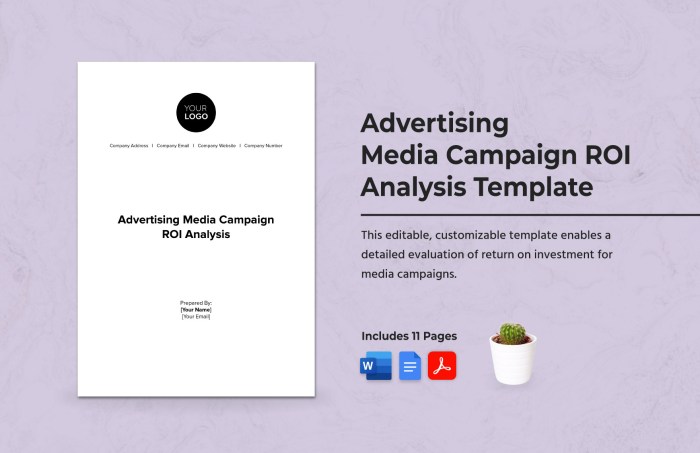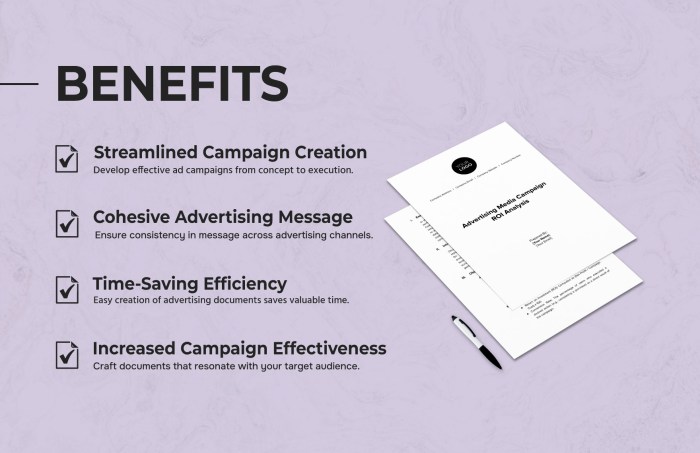
Embark on a journey into the realm of Advertising Campaign ROI analysis, where the effectiveness and success of marketing efforts are dissected and optimized for superior results.
Exploring the intricacies of factors, tools, and methods that influence ROI, this discussion delves deep into the core of marketing analytics.
Understanding Advertising Campaign ROI Analysis
ROI (Return on Investment) analysis in advertising campaigns is a crucial process to measure the effectiveness and success of marketing efforts. It helps businesses understand how much revenue is generated in comparison to the amount spent on advertising.
Key Performance Indicators (KPIs) in ROI Analysis
Key Performance Indicators are essential metrics used to evaluate the performance of advertising campaigns and calculate ROI. Some common KPIs include:
- Conversion Rate: Measures the percentage of users who take a desired action, such as making a purchase or signing up for a newsletter, after interacting with the ad.
- Click-Through Rate (CTR): Indicates the percentage of people who clicked on an ad after seeing it, reflecting its relevance and engagement.
- Cost per Acquisition (CPA): Determines the average cost incurred to acquire a new customer through the advertising campaign.
- Return on Ad Spend (ROAS): Calculates the revenue generated for every dollar spent on advertising, providing insights into profitability.
Effectiveness Evaluation through ROI Analysis
ROI analysis enables businesses to assess the impact of their advertising campaigns by comparing the generated revenue with the advertising costs. By analyzing ROI, companies can identify the most successful campaigns, optimize marketing strategies, and allocate resources efficiently to achieve higher returns on investment.
Factors Influencing Advertising Campaign ROI
When analyzing the return on investment (ROI) of an advertising campaign, several factors come into play that can significantly influence the outcome. Understanding these factors is crucial for making informed decisions and maximizing the effectiveness of marketing efforts.
Impact of Market Trends and Consumer Behavior
Market trends and consumer behavior play a vital role in determining the success of an advertising campaign and its ROI. Keeping up with the latest trends and understanding how consumers behave can help marketers tailor their campaigns to meet the needs and preferences of their target audience. By aligning the campaign with current market trends and consumer behavior, companies can increase the chances of a higher ROI.
Significance of Target Audience Segmentation
Target audience segmentation is another key factor that affects the ROI of an advertising campaign. By dividing the target audience into specific segments based on demographics, psychographics, and behavior, marketers can create personalized and targeted campaigns that resonate with different groups of consumers. This approach not only helps in reaching the right audience but also improves the overall effectiveness of the campaign, leading to a higher ROI.
Tools and Methods for Calculating ROI
When it comes to calculating the Return on Investment (ROI) of an advertising campaign, there are various tools and methods available to help marketers analyze the effectiveness of their efforts.
Different Tools for Calculating Advertising Campaign ROI
- Google Analytics: A popular tool that provides insights into website traffic, conversions, and revenue generated from different marketing channels.
- ROI Calculators: Online tools that allow marketers to input campaign costs and results to calculate ROI quickly.
- CRM Software: Customer Relationship Management software can track leads and conversions back to specific advertising campaigns.
Comparison of Traditional Methods with Digital Tools for ROI Analysis
- Traditional methods like manual tracking of sales and leads can be time-consuming and prone to errors, while digital tools offer real-time data and automation for more accurate analysis.
- Digital tools can track online and offline conversions, providing a more comprehensive view of campaign performance compared to traditional methods.
Process of Calculating ROI Using Attribution Models
Attribution models help marketers determine which touchpoints in the customer journey contribute most to conversions and ROI. The process involves assigning credit to different marketing channels based on their impact on driving sales.
Common attribution models include First Touch, Last Touch, Linear, Time Decay, and U-Shaped, each offering a different perspective on how to allocate credit for conversions.
Importance of Data Analytics in ROI Analysis

Data analytics plays a crucial role in measuring advertising campaign ROI by providing valuable insights into the performance of the campaign. By analyzing data, marketers can determine the effectiveness of their strategies and make informed decisions to optimize future campaigns.
Role of Data Analytics in Measuring ROI
Data analytics helps marketers track key performance indicators (KPIs) such as conversion rates, click-through rates, and customer acquisition costs. By analyzing these metrics, marketers can understand which aspects of the campaign are driving results and where improvements can be made. For example, tracking the ROI of different advertising channels can help determine which channels are most cost-effective in reaching the target audience.
Data-Driven Insights for Optimizing ROI
Data-driven insights from analytics can help marketers optimize ROI for future campaigns by identifying trends, patterns, and opportunities for improvement. For instance, analyzing customer behavior data can reveal preferences and interests, allowing marketers to tailor their messaging and targeting strategies for better results. By leveraging data insights, marketers can allocate resources more effectively and maximize the impact of their advertising efforts.
Examples of Data Metrics in ROI Analysis
Conversion Rate
The percentage of website visitors who take a desired action, such as making a purchase or signing up for a newsletter. A higher conversion rate indicates a more effective campaign.
Return on Ad Spend (ROAS)
The revenue generated from advertising compared to the cost of the advertising campaign. A ROAS greater than 1 indicates a profitable campaign.
Customer Lifetime Value (CLV)
The total revenue a customer is expected to generate over their lifetime. Understanding CLV can help marketers make informed decisions about customer acquisition and retention strategies.
Monitoring and Improving ROI Performance
Monitoring and improving ROI performance throughout an advertising campaign is crucial for maximizing the effectiveness of marketing efforts. By keeping a close eye on key metrics and making necessary adjustments, businesses can ensure they are getting the most out of their advertising spend.
Strategies for Monitoring ROI Performance
- Regularly track key performance indicators (KPIs) such as conversion rates, click-through rates, and cost per acquisition.
- Utilize analytics tools to gather real-time data and insights on campaign performance.
- Implement tracking mechanisms to attribute conversions back to specific ads or campaigns.
- Compare actual results with initial projections to identify areas for improvement.
A/B Testing for Improving ROI
A/B testing involves comparing two versions of an ad or landing page to determine which one performs better in terms of driving conversions. By testing different elements such as headlines, images, or calls to action, businesses can optimize their campaigns for maximum ROI.
ROAS (Return on Advertising Spend) and its Relevance
ROAS is a metric that measures the revenue generated for every dollar spent on advertising. It helps businesses understand the effectiveness of their marketing campaigns in driving sales and revenue. By calculating ROAS, companies can make informed decisions about where to allocate their advertising budget for the best possible return on investment.
Understanding Advertising Campaign Services

Advertising agencies play a crucial role in creating and managing campaigns for businesses. They are responsible for developing creative strategies, designing ad materials, selecting the right media channels, and monitoring campaign performance.
Role of Advertising Agencies
- Advertising agencies help businesses identify their target audience and create tailored messages to reach them effectively.
- They have expertise in market research, consumer behavior, and industry trends to develop impactful campaigns.
- Agencies also negotiate media placements and manage budgets to maximize the reach and impact of advertising efforts.
Types of Advertising Services
- Traditional Advertising: Includes print, radio, TV, and outdoor advertising.
- Digital Advertising: Involves online channels such as social media, search engines, websites, and email marketing.
- Content Marketing: Focuses on creating valuable and relevant content to attract and engage target audiences.
- Public Relations: Manages the reputation and communication of a brand through media relations, events, and influencer partnerships.
Impact of Advertising Services on ROI
- Effective advertising services can help businesses reach their target audience more efficiently, leading to higher conversion rates and increased sales.
- By utilizing the right mix of advertising services, businesses can improve brand visibility, customer engagement, and overall market share.
- Measuring the ROI of advertising services is crucial to identify which strategies are working best and optimize future campaigns for better results.
In conclusion, understanding the nuances of Advertising Campaign ROI analysis is paramount for businesses aiming to enhance their marketing strategies and drive impactful results.
User Queries
What are some key performance indicators (KPIs) used in ROI analysis?
Common KPIs include Conversion Rate, Cost per Acquisition (CPA), and Return on Advertising Spend (ROAS).
How do market trends influence ROI analysis in advertising campaigns?
Market trends impact consumer behavior, affecting campaign performance and ultimately ROI evaluation.
What is the role of data analytics in measuring advertising campaign ROI?
Data analytics provides insights into campaign performance, helping optimize strategies for future success.





